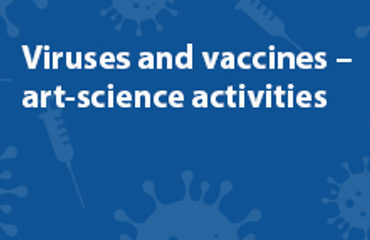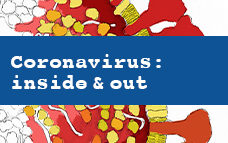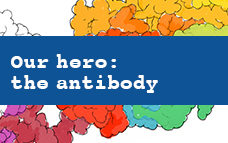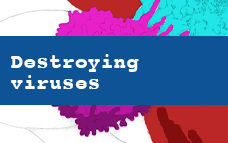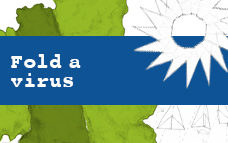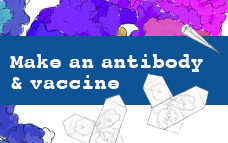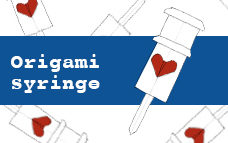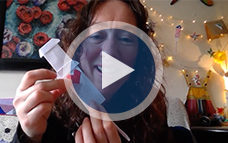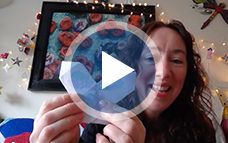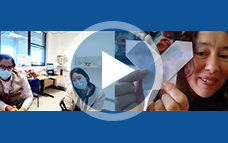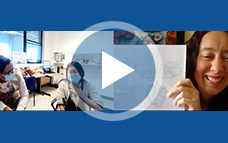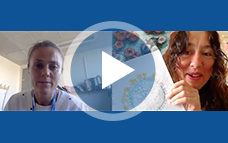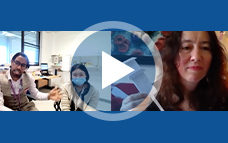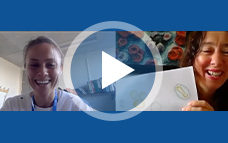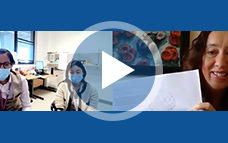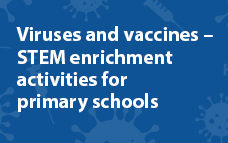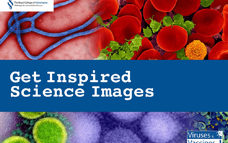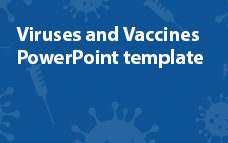Our ‘Viruses and Vaccines’ activity resources have been developed by a team of pathologists, creatives and public engagement practitioners to facilitate informed discussions about viruses and vaccines. The collection below includes art-science resources, guides to hands-on STEM activities for schools, video interviews and guides, and an FAQs section. Use these free resources to explore the fascinating world of viruses, and to understand more about the science behind COVID-19, immunity and vaccines. Pathologists are invited to use the resources as a way to open conversations about these topics with the public, and we’re hopeful they will help dispel common myths and misconceptions.
The Viruses and Vaccines resources cover the following topics:
- The structure of viruses and how this enables them to transmit and replicate between and in human hosts
- Transmission of viruses/ how epidemics start; behaviours that increase/ decrease transmission
- How scientists study viruses and use this understanding to develop vaccines
- Why vaccines are important and how they work.
Many of the resources can be used in supporting delivery of biology concepts and themes found in school curricula.
Art-science activities
Download and print the resources below and use them to discover viruses and vaccines through colouring in and origami. If you don't have a printer you can still do the origami activities using any paper. You can also draw your own viruses and get ideas from the drawings and from our Get Inspired Science Images resource.
Art-science videos
As well as the 'how to fold' origami videos and the 'conversations with pathologists' videos below, you can also enjoy watching Dr Lizzie Burns demonstrating the activities in our time lapse video playlist.
'How to fold' videos
'Conversations with pathologists' videos
Resources for schools
Primary school activities
Secondary school activities
Related activities and resources
- Give It a Shot
- Blossom the Cow
- Blood and Bugs resource pack, which includes:
Frequently asked questions
These questions focus mainly on SARS-CoV-2. For information on other viruses please look at the ‘Virus collection’ resource above. If you have a suggestion for an additional question to add to this list please email [email protected].
Questions about COVID-19
How does COVID-19 infect us?
The virus that causes COVID-19 has been named SARS-CoV-2. It infects our airways (upper respiratory tract and lungs) once it has been inhaled through our nose or mouth. The virus’s outer spike proteins attach to the ACE2 (angiotensin-converting enzyme 2) receptors on our cells. This allows the virus to gain entry into our cells whereupon the genetic information of the virus is translated into proteins and these proteins then assemble into more viruses.
SARS-CoV-2 is an RNA virus, meaning it contains ribonucleic acid (RNA). RNA viruses are different from DNA (deoxyribonucleic acid) ones as they generally have a high mutation rate. The word mutation refers to changes in the virus’s genetic instructions that happen randomly all the time. Usually, mutation is controlled by a process called “proof reading”. However, when a mutation is advantageous to the virus, it will become more prominent in the virus ‘population’. This is why we have seen other more contagious variants (versions) of the SARS-CoV-2 virus appear.
The RNA of the virus uses our cells’ own machinery to make copies of the virus particles, which can go onto infect other healthy cells within the body, as well as being passed onto other individuals through droplets by coughing or sneezing, for example. This is how the virus is transmitted between people. As the virus grows and assembles more viruses in the host, not surprisingly, the cells of the immune system recognise the viral proteins as being non-self and start to react against these antigens. This reaction has two outcomes. The first is the outpouring of antibodies which are directed against various components of the virus. Secondly, the development of T cells, an aggressive form of lymphocyte, which will target the host cells in which the virus is growing because the surface of those cells will carry viral antigens when they become infected.
This short animation explains how the COVID-19 virus, SARS-CoV-2, infects our body.
Is COVID-19 similar to flu?
COVID-19 is the illness caused by the virus SARS-CoV-2, whereas flu is caused by influenza viruses. These illnesses do share some symptoms but there are key differences. The mortality rate amongst symptomatic patients with SARS-CoV-2 infection is greater than that in patients symptomatic with influenza infection. One similarity is that both the flu and COVID-19 tend to cause much more severe disease in older/elderly people. This is why the NHS offers a vaccine to older people against influenza viruses just before the start of winter each year.
Note that there are many cases of asymptomatic seasonal influenza – i.e., you can have flu without having symptoms. There are also many more cases that are sufficiently mild as to not warrant medical attention.
The table shown in this BBC article (source WHO, CDC) compares COVID-19, flu and the common cold. Note that the table only includes people who have symptoms for each of these diseases. Also note that the column labelled ‘Coronavirus’ refers to symptomatic cases of SARS-CoV-2 (the type of coronavirus that causes COVID-19).
SARS-CoV-2 is in a family of viruses called coronaviruses. Coronaviruses are a large family of viruses that are known to cause illnesses ranging from the common cold to more severe diseases including COVID-19, Middle East Respiratory Syndrome (MERS) and Severe Acute Respiratory Syndrome (SARS). Coronaviruses are widespread in the animal kingdom.
Why do some people become seriously ill with COVID-19?
Older people and those with underlying health conditions are at greater risk of becoming severely ill or dying if they catch COVID-19. The reasons for this are likely to be multifactorial. While we cannot change many of these risk factors (e.g. our genes), there are risk factors such as obesity that can be modified. These risk factors have an important impact on your risk of becoming unwell from COVID-19, as well as your general health..
Read more about scientific findings on the role genes can play in severity of illness with COVID-19 here.
Questions about immunity
What is immunity?
Immunity is often discussed in terms of our body’s ability to defend itself against infections from organisms such as bacteria, viruses, fungi and parasites. It is important to also remember what immunity is more broadly – it can be thought of as a feature of cell-to-cell interaction, and a way in which the body, as a multicell organism, can identify what is ‘self’ and what is ‘not self’. The exposure to ‘nonself’, if recognised as such, will be remembered by the body’s immune system, and it is this memory which is conceptually ‘immunity’.
Find out more about immunity and immunology on the British Society for Immunology’s ‘What is immunology?’ page and via their ‘Bitesized Immunology’ resources.
How does our immune system work?
Different cells within our immune system work together to protect us against potentially harmful, disease-causing agents, such as bacteria, viruses, fungi (collectively known as ‘pathogens’) and harmful substances called toxins. Pathogens are infectious organisms which cause disease. Pathogens are covered with proteins called antigens, which our immune system recognises as being not being part of us or something that shouldn’t be in the body, and this triggers an immune response.
The human immune system can be divided into two parts, which work together: the innate immune system and the adaptive immune system. The innate immune system is largely non-specific and provides a general defence against harm. Innate immunity includes physical barriers (e.g., skin, saliva etc.) and immune cells (e.g. macrophages, neutrophils, basophils, mast cells etc.). Natural ‘killer’ cells and ‘eating cells’ called phagocytes are two examples of cells in the innate immune system. Find out more about how macrophages (one type of phagocyte) detect and destroy harmful organisms on the British Society for Immunology’s website.
The adaptive, or specific immune system makes Y-shaped proteins called antibodies to protect your body from a specific invader. These antibodies are developed by cells called B lymphocytes when the body is exposed to a non-self antigen usually on an organism with the ability to invade the host (e.g. a pathogen). The B lymphocytes form memory cells, which remember that particular non-self marker on the invading organism/pathogen. If the same pathogen enters the body again, the immune system would be able to recognise the invader and launch a fast and specific attack. This involves the generation of a low level of circulating antibodies, the ‘memory cells’ mentioned above, that can ‘inactivate’ invaders so they can’t cause infection (get a foothold). Also involved are T cells, which are directed especially towards pathogens that have taken over cells. T cells can directly kill infected cells or help control the antibody response. The adaptive immune system is able to learn and adapt, so the body can also fight invading pathogens that change over time.
This TED-Ed video explains how the immune system works.
What is herd immunity?
Herd immunity occurs when a large proportion of the community are immune to a specific disease either through immunisation with a vaccine or from recovery from the disease after being infected. For highly infectious and potentially life-threatening diseases, such as COVID-19 or measles, vaccines provide a safer way to achieve herd immunity than exposing the whole community to the disease. Individuals who have received a vaccine or are immune from natural infection don’t get ill when exposed to the disease. Being immune to a disease is not the same as being immune to infection and there is now good evidence that even if somebody has been made immune either by exposure to previous infection or through the receipt of vaccine, they may still become infected and be able to transmit the infection to other people. Nevertheless, the majority of people who test positive for antibodies, either through vaccine or recovery, will not become infected. This reduces the ‘chain of transmission’ and can stop the disease from being passed easily from person to person through the population. This is herd immunity.
The proportion of the community that needs to be immunised in order for herd immunity to occur depends on the reproduction rate of the disease. This is the number of people on average that one infected person will pass the infection on to (also known as the ‘R’ rate). In the case of measles, which is highly infectious, 17 out of 18 people in the population would need to be immunised with the MMR vaccine in order for herd immunity to be achieved.
Herd immunity is especially important for protecting vulnerable individuals in the community who can’t be given immunity through vaccination. For example, if they are too old, too young or have weak immune systems. If enough of the population do not get the vaccine, herd immunity breaks down, which means these vulnerable members of the community are no longer protected and the disease is able to spread throughout the population. It is therefore important that as many people as possible get vaccinated.
Watch our herd immunity animation. Johns Hopkins University have also explored whether herd immunity can be achieved for COVID-19 here.
Questions about vaccines and immunisation
What is a vaccine and how do they work?
A vaccine is a type of medicine that teaches our immune system how to create specific antibodies and lymphocytes against a particular disease and the pathogen that causes the disease. There are different types of vaccines, but in general, they consist of either a killed pathogen, a part of the virus the immune system recognises like a protein, or more commonly, an artificially-made component of the pathogen. Sometimes a living pathogen which has been altered so that it is unable to cause disease (but is still infectious) is used in a vaccine. Vaccines are given to prevent a disease rather than treat it. It's much safer for your immune system to learn how to fight the pathogen through immunisation than by catching diseases and treating them. Once your immune system knows how to fight a disease, it will remember this and can often protect you for many years.
When you receive a vaccine, muscle cells at the inoculation site (where the needle went in!) produce ‘spike proteins’ – these are proteins found on the virus the vaccine is protecting you from. These spike proteins are harmless but allow our immune system to generate antibodies so that when we encounter the actual virus, we already have some protection.
For more information on what is in a vaccine, check out this infographic from the British Society for Immunology (BSI).
Find out more about the different COVID-19 vaccines on the BSI website.
Why are vaccines important?
Vaccines save lives. Without vaccines we would still be living with life-threatening diseases such as smallpox and polio. Diseases such as COVID-19 affect all organs of the body, so we cannot take them lightly. Many of those who have been infected are suffering from long COVID too, so we are still learning about the impacts of catching the coronavirus even if we survive. Immunisation with a vaccine can prevent more people from suffering these effects.
Find out more about vaccines in our Give It a Shot activity pack.
What is the difference between vaccination and immunisation?
Vaccination, as a scientific term, means the administration of a ‘pox vaccine’ – i.e. inoculation with the vaccinia virus against smallpox. This is because the word ‘vaccine’ is derived from the Latin word for cow (vacca), reflecting the origins of smallpox vaccination and Edward Jenner’s experiments with cowpox. Inoculation with anything else should, strictly speaking, be referred to as ‘immunisation’. Immunisation is a blanket term for using any vaccine including pox vaccines.
Many people and organisations will use the word ‘vaccination’ interchangeably with ‘immunisation’. E.g. The NHS. In the case of COVID-19, ‘vaccination’ refers to getting the injection that administers the vaccine into your body. The term can also refer to receiving a vaccine via nasal spray or by some other means. Immunisation can be thought of as referring to receiving a vaccine and then becoming immune to a disease.
We now have vaccines to prevent more than 20 life-threatening diseases and the word ‘vaccine’ can be used to refer to the medical preparation that provides active acquired immunity to any of these infectious diseases.
There are a number of different COVID-19 vaccines. What’s the difference between them?
There is a wide range of approaches being used to develop vaccines against the SARS-CoV-2 virus, which causes COVID-19. Please note that this list is not comprehensive and covers mostly those in the later stages of approval. We will aim to update this information as and when new information is available.
• The Pfizer BioNTech, Moderna and CureVac vaccines are all mRNA (messenger ribonucleic acid) vaccines.
• The Imperial College and Arcturus vaccines are saRNA viruses (self-amplifying ribonucleic acid) vaccines.
• The Oxford/AstraZeneca and ReiThera vaccines are primate adenovirus vector vaccines.
• The Gamaleya, Johnson&Johnson and Cansino Biologics vaccines are human adenovirus vector vaccines.
RNA vaccines are made of synthetic RNA easily created in the lab to mimic the viral RNA. When taken up by our cells, the RNA starts to make the viral spike protein which causes our immune system to kick in. Self-amplifying RNA vaccines, as their name suggests, can create a lot more copies of themselves than mRNA vaccines, so we only need small doses of them. RNA vaccines need to be stored at much lower temperatures (think dry ice and liquid nitrogen temperatures!) so they won’t break down. There are current trials to test storage of these vaccines at the more achievable temperature of -15°C.
Viral vectors vaccines use a harmless form of a virus to carry the genetic material that codes for the viral spike protein to our cells. (In the examples above these are human or primate adenoviruses). Once this vector is inside of us, again our immune system recognises the foreign proteins. Viral vector vaccines don’t need to be stored or transported at such low temperatures as RNA vaccines. Read more about the Oxford AstraZeneca vaccine here.
You can find out more about the different types of vaccines here.
How were the vaccines tested? Are they safe?
In general, there are five stages involved in developing a vaccine. Throughout these stages, vaccines are rigorously tested to ensure that they are safe to use, with minimal side effects and the correct dosage is also determined. The COVID-19 vaccines were developed using the same process outlined below but the timelines were much shorter. This is explained in a later question in this section of the FAQs.
1. Exploratory research: over the course of two to five years, researchers work within their labs to identify natural or synthetic antigens, that can be used to create a safe immune response to the disease in question.
2. Pre-clinical stage: tissue or cell cultures and animal testing are carried out during the pre-clinical studies to find out how safe the candidate vaccine is, and if it is able to provoke an immune response. These studies allow researchers to predict what the response to the vaccine might be like in humans. It also provides an opportunity to fine tune the vaccine dose, check its safety and tailor the delivery method before the next stage, where the vaccine will be tested in humans. Researchers may start with many candidate vaccines and whittle them down to the most effective ones during this stage.
3. Next comes the human clinical trials stage, which has three phases. During each phase the vaccine is tested on progressively larger groups of volunteers.
- Phase I: the safety of the vaccine is tested on a 10-100 healthy volunteers during this phase. This usually takes about two years.
- Phase II usually takes two to three years, during which hundreds of volunteers (including a placebo control group and people who have had the disease and recovered) take part in randomised trials to investigate the immune system’s response to the vaccine, how safe the vaccine is and the right dosage to use. Because the number of volunteers in phases I and II is relatively small, any side effects that show up are considered to be ‘common’ depends upon the event.
- Phase III can usually take up to 10 years and requires thousands of volunteers, including a placebo control group who won’t receive the vaccine. If fewer volunteers in the vaccine group become ill than those in the placebo group, this provides evidence that the vaccine does in fact prevent disease. Phase III also allows researchers to pick up less common side effects of the vaccine being studied.
4. The information that has been collected about the vaccine’s safety and effectiveness has to be submitted to regulatory authorities to be reviewed before the vaccine can be approved/licenced for use. Pharmaceutical companies continue to monitor the safety and effectiveness of the vaccine even after it has been licensed.
5. The vaccine is then manufactured with lots of checks along the way to ensure high quality and it is then delivered for use.How were the COVID-19 vaccines developed so quickly?
Generally speaking, it can take over 10 years to develop a vaccine for a disease. However, in the case of the COVID-19 vaccines, it has been possible to speed up the usual development process, without compromising the safety of the vaccines. There are several reasons for this.
- Collaboration: scientists, doctors, ethics approval boards, manufacturers and regulatory agencies around the world have all worked collaboratively towards finding and testing vaccines against COVID-19.
- Advances in science: scientists used advances in vaccine technology, which have been developed over many years of research. For example, the idea of using mRNA to generate useful proteins to fight disease has been around for decades. However, vaccines using this technology have only very recently made it to clinical trials.
- Funding: governments and funding bodies have worked together to invest more money towards COVID-19 vaccine development.
- Volunteers: tens of thousands of willing volunteers signed up for the COVID-19 vaccine clinical trials, allowing the vaccines to be tested more quickly. It usually takes much longer to recruit volunteers for clinical trials.
- Manufacturing: innovations in vaccine platform technologies, such as RapidVAC, enable more doses of vaccine to be manufactured within a shorter timeframe.
This TED-Ed video explains how vaccines can be developed quickly during a pandemic and this Channel 4 News video explains how the COVID-19 vaccines were developed so quickly.
I have heard the vaccine has DNA from the virus in it. What happens to it when it is injected into my body and can it affect my DNA?
Some of the COVID-19 vaccines have been created using genetic codes (in the form of mRNA) from the SARS-CoV-2 virus. mRNA vaccines, such as the Pfizer/BioNTech vaccine, teach our cells how to make a harmless piece of the virus called the spike protein, which consequently triggers an immune response in our bodies. This trains our immune system to safely develop immunity without developing the disease. If the body is later exposed to the real virus, it will already be able to recognise it and defend against it using the antibodies created as a result of immunisation.
The mRNA from the COVID-19 vaccine cannot reach the nucleus of the cell, where our DNA is kept, and therefore, the mRNA cannot change or interact with our body’s DNA. mRNA also cannot be translated back into DNA, as neither the virus nor the human cells have the tools needed to copy or edit RNA into our DNA. Additionally, the new vaccines cannot replicate inside our body and only stay inside our body for a few days. Once the vaccine has helped our cells create an immune response against the virus’s spike protein, the vaccine is removed by our body.
What happens If the virus keeps evolving and mutating?
Most COVID-19 vaccines that are currently available or being developed train our immune system to detect antigens on the surface of the current SARS-CoV-2 virus. Many treatments look at how to block the virus spike protein and its interaction with ACE2 receptors. However, mutations to the spike protein cause the main SARS-CoV-2 variants, referred to as ‘variants of concern’. Such variants are being closely monitored by scientists as there is potential for them to decrease the effectiveness of current vaccines.
Variants that have an enhanced ability to bind to human cells have an advantage over previous variants – this is why these have now become the dominant virus in many countries, not only the UK.
Studies are ongoing but there is some evidence that changes to the SARS-CoV-2 virus will affect how well vaccines or treatments work. However, there are studies that indicate vaccine-induced antibodies will neutralise the virus in the laboratory. In addition, existing vaccines can be adapted to counter this; it won’t be necessary to develop new vaccines. Scientists are keeping a close eye on the changes to the virus.
One advantage to the new vaccines that are being produced is that it is relatively quick and easy to incorporate any changes to the virus’s genetic code. Some researchers have also identified regions of the virus’s genetic material that don’t mutate as much, which could be the perfect targets for new vaccines (and potentially new treatments).
Read this BBC news article about new coronavirus variants and this Guardian article about the UK and South African COVID-19 variants.
Who is making the vaccines and where are they being made? Can we trust the companies who are producing them?
The two vaccines that are currently approved for use in the UK are being manufactured by pharmaceutical companies.
The Pfizer–BioNTech COVID‑19 vaccine was developed by BioNTech (based in Germany) in cooperation with Pfizer (an American multinational pharmaceutical corporation). Trials of this vaccine started in April 2020 and it was tested on 40,000 people by November 2020. It is manufactured in a number of specialist facilities owned by Pfizer and BioNTech in the United States and Europe in a three-stage process. The results of the clinical trials showed a 95% reduction in disease incidence in an immunised group compared to an unimmunised group; the data of these trials were published in scientific journals that are checked by other experts for accuracy and validity.
The Oxford-AstraZeneca vaccine was developed by a research team at the University of Oxford in collaboration with the UK based pharmaceutical company, AstraZeneca. The research was carried out by Oxford University's Jenner Institute and Oxford Vaccine Group. AstraZeneca is a British-Swedish multi-national pharmaceutical corporation with its head-quarters in Cambridge in the UK. An Italian manufacturer Advent Srl, located in Pomezia, produced the first batch of the COVID-19 vaccine for clinical testing. Trials involving over 17,000 people showed a 76% reduction in disease in immunised vs. unimmunised people. Following approval, production of this vaccine was scaled up and large plants in the UK and Europe are currently producing doses in their millions.
Both of these vaccines have been authorised for use by independent regulators in a number of countries including the Medicines and Healthcare products Regulatory Agency (MHRA) in the UK. The European Medicine Agency (EMA) has also recommended authorisation of both of these vaccines.
Pharmaceutical companies are only able to use and sell any vaccines or medicines after independent bodies, such as the MHRA, make sure that medicines, vaccines and medical devices work properly and meet the standards of safety, quality and efficacy. The independent bodies also continue to monitor the safety of medicines once licensed. This web resource, provided by the Oxford Vaccine Group, provides further useful background information on how vaccines are tested, licenced and monitored.
A third vaccine has also been approved for use in the UK from the spring. The Moderna vaccine is produced by the American pharmaceutical company Moderna. It has undergone clinical trials on the same scale as other approved vaccines and has been shown to have 94% efficacy. Moderna have partnered with the Swiss company Lonza Pharma and Biotech to produce the vaccine on a large scale in the US and in Europe. More information on this vaccine is available here.
The UK’s Joint Committee on Vaccination and Immunisation (JCVI) is an independent group of scientists and experts who advise the Government and our health departments on all aspects of its vaccination programme, including vaccine safety.
Specific concerns/ questions about COVID and the vaccines
I am young and healthy, so if I catch COVID-19 it is unlikely I will get seriously ill. I also don’t like taking medicines for anything – I prefer to ‘ride it out’. Why should I get a vaccine?
Getting immunised against COVID-19 not only protects you, but it also protects others in your community who would have a higher chance of severe illness or death if they caught COVID-19, for example, elderly people and people with chronic conditions. It is not known what percentage of people need to be immunised against COVID-19 to achieve ‘herd immunity’ - see our animation about this. We will know more as more studies are done. In any case, it’s important that as many people who can be immunised safely receive their vaccine. It will protect those who are unable to get the vaccine for specific medical reasons.
If we can all do as much as we can personally to stop ourselves and others catching and transmitting this virus, including accepting a vaccine, this will reduce the number of people getting ill, being hospitalised and dying, and will help our ‘return to normal life’ to happen more quickly. While it’s true the majority of people who get seriously ill or die due to COVID-19 are older and/or have underlying health conditions, it is still possible to be young and healthy and get very ill or even die because of this virus. Even if you have mild symptoms, the loss in your sense of smell and/or taste could continue for several months after your other symptoms have gone. Some people, who were in perfect health before catching COVID, even continue to suffer virus-like symptoms after the initial infection has gone – this can last for months and is known as ‘long-COVID’. You can find out more about long COVID here.
Why is it easier to catch COVID-19 indoors?
The risk of catching COVID-19 is much higher indoors. The virus is more easily transmitted when you’re in closed areas, where there’s less ventilation or room for airflow. This is especially true for small spaces, like elevators. Good ventilation helps protect against infection and being outdoors is safest of all. It is possible to be infectious even with no symptoms. Wearing a mask helps prevent infection from spreading from those who are infected.
If I have had COVID-19 do I still need to get a vaccine?
Yes! It is not known how long you remain immune to COVID-19 after you’ve had it. There have also been a few cases where people have been reinfected with COVID for a second time. Some vaccines can stimulate longer-lasting immunity than natural infection. This depends on the virus but it’s recommended that even if you’ve had COVID-19, you should still get a vaccine when it becomes available to you.
Once I have been immunised against COVID-19 can I still transmit the virus to others?
Most vaccines don't fully protect against infection, even if they can block symptoms from appearing. As a result, immunised people will unknowingly carry and spread viruses and other infectious diseases. In the case of the COVID-19 vaccines, there is still only limited evidence on the extent to which immunised people can pass on the virus to others. You might think that once enough people have received a vaccine, it doesn't matter if they are still able to spread the virus – everyone will have immunity. However, there will be people in the population who are unable to receive a vaccine, for example because they are too young/old, or too unwell. So even if you have been immunised against COVID-19, it’s best to continue behaving as if you haven’t (i.e. by washing your hands, keeping your distance and wearing a face covering), at least until studies about this have told us more.
My grandparents/ parents have now been immunised. Can I hug them?
Those who have been immunised with both doses will have a high level of protection against catching COVID-19. Some initial studies have indicated the vaccines also reduce the ability of individuals to transmit the virus to others. However, at the time of writing the extent to which immunised people may still transmit the virus is not completely understood.
In addition, there is evidence that COVID-19 can survive on surfaces such as clothing and doors, and contaminated surfaces, in a form known as ‘fomites’, which may be a source of transmission of this virus between people. The research on this is ongoing and some scientists argue it’s best to focus on reducing transmission via breathing in other’s air. Until more is known, it is best to be cautious and to assume you could spread COVID-19 to friends and relatives by leaving virus particles on surfaces in their home (even if they’re immunised, others who are not could then visit and pick up the virus). It’s best to keep contact with loved ones virtual until the UK vaccination programme has been completed. Remember that after your second dose of the vaccine, you won’t be protected from catching COVID-19 straight away. It takes around 21 days for your body to build up enough antibodies (the special proteins that can fight the virus).
I have asthma - am I at risk of an allergic reaction to the vaccine?
The COVID-19 vaccine is safe for people with asthma and other lung conditions. The vaccines have been tested on people with long-term conditions and on people from a range of age groups, including older people. The Joint Committee on Vaccination and Immunisation (JCVI) has decided it is safe for people with long-term conditions and that people who are high-risk should be prioritised to get the vaccine first. There is no reason to think the vaccination interacts with any asthma medications.
If you have ever had an allergic reaction to a vaccine before, you should tell your doctor the details of this when you are called for your vaccine appointment. Only a very small number of people have had a serious allergic reaction to the COVID-19 vaccines – it is extremely rare.
The current advice from the JCVI means that people whose asthma is under control will not be prioritised for the COVID-19 vaccine. Sufferers of the condition will not be on the list ahead of their peers unless they are formally shielding, regularly take steroid tablets or have ever had an emergency hospital admission. If you’re asthmatic and have concerns about the vaccine, the British Lung Foundation may be able to help.
Questions about COVID-19 vaccines and fasting during Ramadan
These questions and answers were prepared by Imam Mohsen Elbeltagi, Swansea University Mosque, and reviewed by consultant medical microbiologist, Dr Angharad Davies, consultant histopathologist, Professor Sarah Coupland and consultant ophthalmologist Dr Rumana Hussain.
You can find more FAQs and answers on the British Islamic Medical Association website and the Muslim Doctors' Association website. The World Health Organisation's guidance on safe Ramadan practices during COVID-19 is also useful.
.
Does taking the COVID-19 vaccine break the fast?
Taking the COVID-19 vaccines currently licenced in the UK does not invalidate the fast, and it is permissible for the fasting person to have the jab given at one of the vaccine centres. Contemporary Muslim scholars have deemed the non-nutritious injections inconsequential to the fast and would not invalidate it. Individuals should not delay their COVID vaccines on the account of Ramadan.
This is the verdict (fatwa) of the International Islamic Fiqh Academy and various fatwa agencies in several Muslim countries. The basis of this fatwa is that such injections are not like eating or drinking in form (entry into the hollow interior) or purpose (nutrition and hydration). Based on this, there is no harm or issue in getting the COVID-19 vaccine while fasting in Ramadan.
What if I experience intolerable side effects from the COVID-19 vaccine during fasting?
Most side effects are mild, lasting a few hours (maximum 1 day) and are self- limiting. However, should an individual become more unwell after receiving the vaccine, then it is permissible for the individual to break the fast due to the illness; for example, taking paracetamol or a similar over-the-counter anti-inflammatory painkiller. Find out more about possible side effects of the COVID-19 vaccines here: https://www.nhs.uk/conditions/coronavirus-covid-19/coronavirus-vaccination/coronavirus-vaccine/
Are pregnant and breastfeeding women allowed to miss fasting due to fear of the COVID vaccine side effects?
It’s permissible for pregnant and nursing women to break their fast if they need to, and to feed one poor person per day instead. They should make up for the missed days whenever is possible.
At the time of writing, pregnant women are not routinely being offered the COVID-19 vaccine. More information here: https://www.rcog.org.uk/en/guidelines-research-services/coronavirus-covid-19-pregnancy-and-womens-health/covid-19-vaccines-and-pregnancy/covid-19-vaccines-pregnancy-and-breastfeeding/.
Public Health England’s guidance on COVID-19 vaccination for women of childbearing age, pregnant or breastfeeding states: ‘There are no data on the safety of COVID-19 vaccines in breastfeeding or on the breastfed infant. Despite this, COVID-19 vaccines are not thought to be a risk to the breastfeeding infant, and the benefits of breastfeeding are well known. Because of this, JCVI has recommended that the vaccine can be received whilst breastfeeding. This is in line with recommendations in the US and from the World Health Organisation.’

